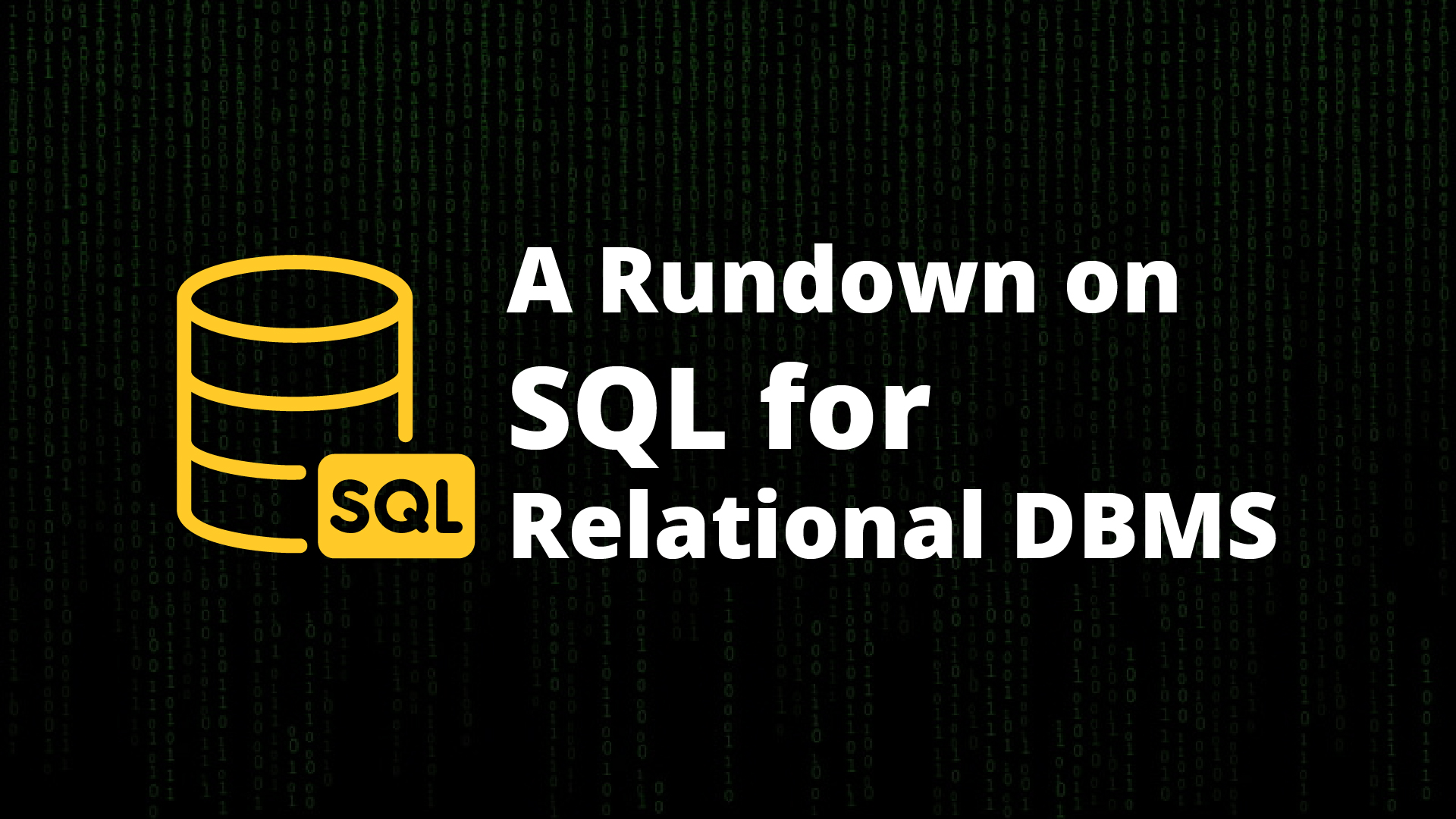A Rundown on Structured Query Language for Relational Database Management Systems
 ASM Najmus Sakib Khan
ASM Najmus Sakib Khan
I’ve completed the course, “CSE370 - Database Systems”, this semester (Spring 2024), while I’m soon concluding my B.Sc. in CSE from BRAC University. For this course, I had to go through DBMS and SQL. Structured Query Language (SQL) is the standard language for interacting with relational databases. Its versatility makes it an essential tool across industries. For example, an e-commerce company might use SQL to analyze sales data, identify trends and make data-driven decisions to optimize its business strategy. Popular relational database management systems that use SQL include MySQL, PostgreSQL, Oracle and SQL Server. SQL is the backbone of database management systems (DBMS). It’s an essential tool for anyone who works with data, from analysts and data scientists to software engineers and business managers. SQL enables users to create, manipulate and retrieve data stored in databases, providing a powerful means of handling complex data relationships. In this article, I’ve looked upon the key concepts and techniques you need to know to work effectively with SQL, while learning SQL.
Introduction to SQL
SQL is a standard language for accessing and managing databases. It’s designed to work with relational database systems, which store data in tables. These tables contain rows and columns and each row represents a record while each column represents a specific attribute of the data. SQL is a domain-specific language designed for managing data in relational databases. It was developed in the 1970s and has become the industry standard for working with data. SQL enables you to perform various tasks such as querying, updating and manipulating data in tables. A table is a collection of rows and columns, where each row represents a record and each column represents an attribute of the data.
SQL Commands
Understanding the different categories of SQL commands can be helpful for navigating database management more effectively. There are 5 SQL commands; DDL, DML, DQL, DCL and TCL.
Data Definition Language (DDL) Commands are used to define and manage the structure of database objects like tables, indexes, views and schemas. These commands shape the database at the schema level, which includes creating, modifying, or deleting database objects.
Data Manipulation Language (DML) Commands allow you to manipulate data within existing tables. These commands are used to insert, update, delete and retrieve data from the database.
Data Query Language (DQL) in SQL refers primarily to the ‘SELECT’ statement and its variations. These commands are used to retrieve data from one or more tables in a database. They allow you to filter, sort and format the data as needed. Although DQL is not a separate official category in SQL standards, it is considered part of Data Manipulation Language or DML, it is useful to consider ‘SELECT’ and its related clauses as part of a distinct category for data querying.
Data Control Language (DCL) Commands manage user permissions and access control to the database. They help grant and revoke privileges on various database objects.
Transaction Control Language (TCL) Commands manage transactions in the database. A transaction is a series of operations that are treated as a single unit, ensuring data integrity.
SQL Operations
At the core of SQL are databases, which store and organize data. Within a database, data is structured into tables, with columns defining data fields and rows representing individual records. Effective database design involves normalization, a process of organizing data to minimize redundancy and dependency. To maintain data integrity, tables utilize constraints. Primary keys uniquely identify each row, while foreign keys establish relationships between tables.
For instance, a “products” table might have a primary key, “product_id” and an “orders” table could use “product_id” as a foreign key to link each order to a specific product. Other constraints include UNIQUE, which ensures no duplicate values; CHECK, which enforces conditions on data; and DEFAULT, which specifies a default value for a column.
SQL provides a range of operations to interact with data. The SELECT statement retrieves data from one or more tables, allowing filtering, sorting and joining. JOIN operations combine data from related tables, with different types like INNER JOIN, LEFT JOIN, RIGHT JOIN and FULL OUTER JOIN. For example, an INNER JOIN on the “customers” and “orders” tables would return all customers with their associated orders, excluding customers without orders and orders without a customer.
To manipulate data, we use INSERT to add new records, UPDATE to modify existing data and DELETE to remove records. These operations can be combined with subqueries, which are nested queries within another SQL statement. For instance, you could use a subquery in an UPDATE statement to change values based on conditions from another table.
SQL Functions
SQL supports various operators and functions for filtering and transforming data. Logical operators (AND, OR, NOT) allow compound filter conditions, while numeric operators handle arithmetic operations. String operators enable pattern matching and concatenation. Functions offer powerful data analysis and manipulation capabilities. Numeric functions perform calculations like SUM, AVG and ROUND. String functions manipulate text, such as CONCAT for combining strings or SUBSTRING for extracting characters. Date and time functions handle operations on temporal data, like GETDATE for the current date/time or DATEADD for modifying dates. Aggregate functions (COUNT, MIN, MAX, etc.) summarize data across multiple rows. They are often used with GROUP BY and HAVING clauses for advanced analysis. For example, you could use COUNT and GROUP BY to get the number of orders per customer and HAVING to filter only customers with more than 10 orders.
When creating tables, columns are defined with specific data types to optimize storage and performance. Key types include numeric (INT, DECIMAL), string (VARCHAR, TEXT), date/time (DATE, TIMESTAMP) and boolean (BIT). Indexes are crucial for optimizing query performance, especially on large tables. Indexes allow faster queries by creating a searchable structure, similar to an index in a book. However, they also introduce overhead for insert, update and delete operations.
Beyond data manipulation (DML), SQL includes sub-languages for other tasks. The data definition language (DDL) handles table structure with statements like CREATE TABLE and ALTER TABLE. The data control language (DCL) manages access permissions using GRANT and REVOKE. The transaction control language (TCL) handles transaction management with COMMIT, ROLLBACK and SAVEPOINT, ensuring data integrity through ACID properties.
Best Practices in SQL
Writing clear and readable queries is very important. Using proper formatting and indentation for better readability will be very helpful. Using JOINS for Relational Data can make it easier. Combining data from different tables using JOINs to gain insights will make it very easy. Specifying the columns you want to retrieve instead of using ‘SELECT *’ for performance and clarity can make it clear and readable. Testing queries on a Small Dataset can be timesaving decision. Before running complex queries on large datasets, try to test them on smaller sets to validate the results. Lastly, optimizing queries is important as well. Use indexes and other optimization techniques to enhance performance.
Conclusion
SQL is a powerful language for working with relational databases. The best way to learn is through hands-on practice with real-world datasets. Explore SQL tutorials and online practice platforms and experiment with sample databases. As you advance, dive into topics like query optimization, database normalization and transaction management. With SQL in your toolkit, you'll be equipped to tackle complex data challenges and drive data-informed decision-making in your projects. As you become more proficient, you'll find that SQL can greatly enhance your ability to manage and analyze data effectively. Understanding the basics is a great start and with time and practice, you can delve into more advanced concepts and techniques. Happy querying!
Subscribe to my newsletter
Read articles from ASM Najmus Sakib Khan directly inside your inbox. Subscribe to the newsletter, and don't miss out.
Written by
